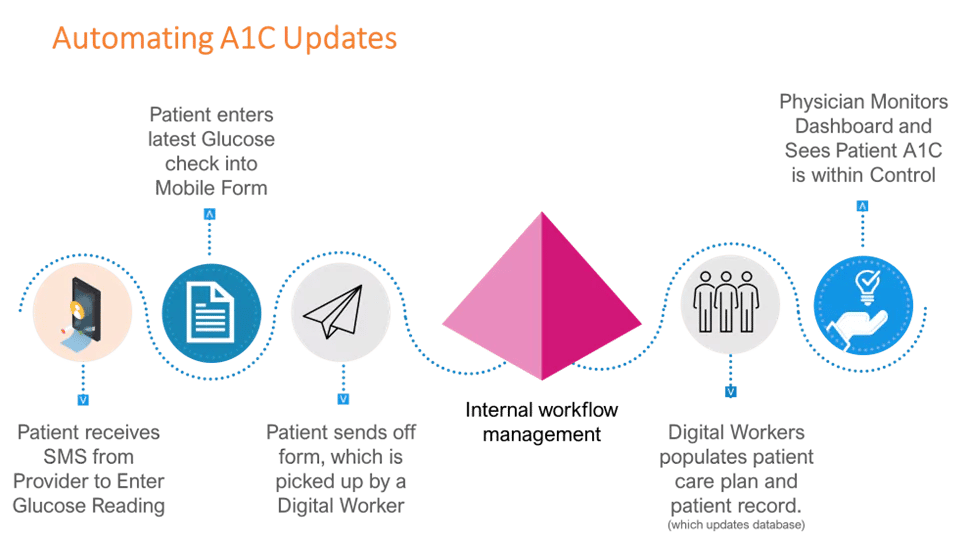BLOG. 6 min read
The Value of Robotic Process Automation (RPA) for Clinicians
February 15, 2024 by Kevin McQueen
With the increased pressure on health plans to not only satisfy consumer demands and compliance regulations but often do so with minimal staffing, many are turning to Robotic Process Automation (RPA). Having worked with remote patient monitoring applications for three years, I have personally seen the value of digital technology and real-time insights from the use of a Continuous Glucose Monitor (CGM) to monitor patient glucose levels and feed data back to the clinician. This experience has solidified my belief in the value of meaningful clinical data to influence patient behavior.
For example, when a patient eats a meal of pasta versus lean protein and vegetables and then observes the direct correlation to their glucose levels, this is a powerful observation and insight for the patient. An ADE I spoke with validated this based on hundreds of patient interactions, and further stated “the data does not lie” when referring to the patient’s glucose levels.
Taking the concept a step further, digital technology in the form of RPA (digital workers) can assist in personalized communication with those patients, encouraging behavior change, enhancing staff productivity and protecting revenue.
How does it work?
The digital worker can assume the role of a clinical patient advocate, assisting clinicians in patient communication and providing helpful personalized feedback to the patient, available any time 24/7.
Digital workers can communicate about risk stratification measures through SMS, text or chatbot formats, leveraging Conversational AI (ConvAI) to message the patient in an impactful, personal way.
Using our glucose monitoring example, a digital worker might reference patient records to recognize patterns and generate questions like, “Patient X, have you noticed your glucose levels return to normal much faster when you exercise at least 120 minutes per week?” These types of questions provide insight that a patient may not have previously had, serving as an impetus to change behavior. In this case, the patient connects exercise with glucose levels, prompting them to a desired behavior: exercise.
Additionally, clinicians can be automatically notified when there is an outlier in the glucose levels that might require attention. When using RPA for diabetes care management, for example, smart alerts based on clinical parameters can monitor patient’s readings and automatically alert the care provider as defined by the care team. When multiple devices are used, i.e., a Fitbit, other patterns can be identified, such as the relationship of glucose levels to exercise and sleep.
This cohesive approach ensures that the digital worker operates in tandem with clinicians while offering the personalized attention patients need.
How does RPA benefit clinicians?
Because this work can be done automatically, clinicians can focus on the immediate needs of patients. They can have peace of mind, trusting that digital workers are continually recognizing patterns: to communicate relevant personalized messaging to other patients in their care, and to push alerts back to the clinicians for outliers.
This is good news for health organizations concerned with staffing challenges since digital workers can replace time spent on these types of high-value tasks, and other repetitive tasks to alleviate administrative burden and potential burnout:
- Schedule appointments, including sending requests for telehealth visits.
- Seamlessly move information from patient to provider.
- Populate care plans.
- Manage prescriptions.
- Recognize patterns from patient records.
- Communicate personalized, impactful insight to patients.
- Notify clinicians when there are outliers.
How does RPA benefit health plans?
Digital workers are 5-10 times more productive than human workers since they are always working behind the scenes. Additionally, they are cost-effective, being about 1/10th the expense of adding additional staff to a patient advocacy program and estimated 110% more effective. Many of the tasks they perform are related to Star ratings, which can assist with protecting revenue for the plan.
Integrating digital labor into a population health program will also enhance health equity among patient populations. For example, when a provider uses population health software, such as our CareAnalyzer platform (integrated with the Johns Hopkins ACG® System), RPA can be employed for pattern recognition and recognize that diabetes should be treated differently based on a patient’s socioeconomic status. The pattern might be identifying food desserts in a lower-income neighborhood, where less fresh fruits and vegetables are available. The insight from this pattern alerts the care manager that additional or different care might be needed for that population base.
Finally, digital workers play a crucial role in ensuring compliance and adherence to regulatory reporting requirements for reimbursement. With precision and efficiency in handling data, the risks associated with non-compliance and inaccuracies in reporting are significantly minimized. This aspect is vital for maintaining the integrity of healthcare programs and ensuring they meet the stringent standards set by healthcare regulators.
While the industry is still discovering new uses for RPA, there is a real opportunity to look past easily automated tasks to a higher-value use of digital workers. In particular, the ability to communicate with patients not only empowers clinicians but can also prompt action. This has the potential to change behavior—the true holy grail in value-based healthcare plans.
If you are considering adding RPA, SS&C is a leader in the field with Blue Prism. The following example illustrates how digital workers can automate A1C updates, enabling a workflow directly from a patient to a provider.

Written by Kevin McQueen
Principal Sales Executive
Related articles

BLOGS. October 28, 2025
Maximizing Alpha by Harnessing Data for Securities Action Recoveries
Read more
BLOGS. December 22, 2022
CMS Medicare Rule for 2023: Is Your Beneficiary RTBT Program Ready?
Read more



